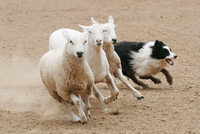
Lead Image © kateleigh, 123RF.com
Distributed storage with Sheepdog
Data Tender
Kazutaka Morita launched the Sheepdog project [1] in 2009. The primary driver was the lack of an open source implementation of a cloud-enabled storage solution – as a kind of counterpart to Amazon's S3. Scalability, (high) availability, and manageability were and still are the essential characteristics that Sheepdog seeks to provide. For Morita, setting up Ceph, which already existed at that time, was just too complicated. GlusterFS in turn was largely unknown. What these tools had in common was that they then tended to address the NAS market.
Sheepdog was intended from the beginning as a storage infrastructure for KVM/QEMU [2] (see also the box "Virtual Images with Sheep"). Because Morita was working at NTT (Nippon Telegraph and Telephone Corporation), there are corresponding copyright notices in the source code, but the code itself is released under the GPLv2.
Virtual Images with Sheep
Sheepdog started life with the objective of being the storage system for QEMU. In 2009, this meant a data store for the hard disk images of the virtual servers. This paradigm is still anchored very deeply in the project. The management of the stored data is based on virtual disk images (VDIs).
The command-line tool uses the vdi keyword to access the storage objects. Even for access via the POSIX layer, sheepfs relies on VDIs behind the scenes. "Normal" files cannot be stored without a few tricks. The user first needs to create a VDI, provide it with a filesystem, and finally mount the VDI.
Sheepdog manages four types of information for each storage object: the actual data, the metadata (name, size, timestamp, ID), the status of the associated virtual server, and the VDI attributes. In principle, you
Buy this article as PDF
(incl. VAT)
Buy ADMIN Magazine
Subscribe to our ADMIN Newsletters
Subscribe to our Linux Newsletters
Find Linux and Open Source Jobs
Most Popular
Support Our Work
ADMIN content is made possible with support from readers like you. Please consider contributing when you've found an article to be beneficial.






